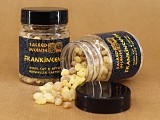Kenya, Resin, Cut & Sifted, 60 Ml, 35 Gr from Kenya (SKU 3840)
This Myrrh variety from Kenya offers a warm, earthy, balsamic aroma that is ideal for spiritual cleansing and meditation. Known for its gentle, grounding effect, Myrrh’s fine grains burn gradually on hot charcoal, filling the space with a balanced, discreet fragrance that calms the mind and uplifts the spirit. Traditionally revered in ancient Egypt, Greece, and Rome, Myrrh has been used for purification, meditation, and as a healing tool. Its smoke is said to enhance focus, visualization, and emotional resilience. The Kenyan Myrrh’s subtle yet profound scent combines beautifully with Frankincense or Sandalwood, creating a calming atmosphere perfect for rituals, meditation, or as a protective presence in any room. More information below.
Packed in 60 ml clear plastic pots containing 35 gram.
Myrrh Incense Resin
Myrrh (Commiphora myrrha), a sacred resin revered since ancient times, offers a warm, earthy, balsamic aroma ideal for spiritual and meditative practices. Harvested from small, knotted shrubs in Somalia, Ethiopia, Yemen, and South Arabia, Myrrh forms as fine grains or small nuggets when the resin hardens after dripping from cuts in the bark. These grains are perfectly suited for a subtle, controlled burn, adding a gentle, grounding fragrance that isn’t overpowering.
Aromatic and Spiritual Qualities
Myrrh’s scent is rich, spicy, and earthy, with woody, calming undertones that center the mind and uplift the spirit. When burned, Myrrh releases a pleasant, sedative aroma, creating a purified and spiritually enriching atmosphere. Known to enhance focus, visualization, and emotional resilience, Myrrh is frequently used by aromatherapists and meditators to foster inner peace, protection, and comfort, making it ideal for grounding rituals, meditation, and healing practices.
Traditional Uses and Historical Significance
Myrrh has been highly prized throughout history, often valued even more than gold. Its sacred reputation made it a key ingredient in Egyptian embalming practices and ancient Greek and Roman ceremonies, where it was used to crown guests, flavor wines, and create perfumes. In ancient medicinal practices, including Ayurveda and Chinese medicine, Myrrh was renowned for its therapeutic qualities. The word “Myrrh” is derived from Mur, meaning “bitter” in Hebrew and Arabic, a nod to its distinct taste and potent qualities.
Burning Characteristics and Application
Myrrh grains can be sprinkled directly over hot charcoal to release their full, rich fragrance gradually, allowing for a controlled, discrete scent. The smoke from Myrrh is grounding and purifying, ideal for clearing the mind and fostering a calm atmosphere. Its slow burn and warm aroma make it perfect for long ceremonies or meditation sessions, as the fragrance subtly fills the space, promoting a steady, peaceful environment.
Blending and Modern Applications
Myrrh’s aroma combines well with other grounding incenses such as Frankincense, Palo Santo, and Sandalwood, enhancing its spiritual depth in incense blends. Suitable for any spiritual setting, Myrrh brings depth, balance, and a connection to ancient traditions, making it an invaluable ally in modern spiritual practice.
Perfect for meditation, space cleansing, or daily rituals, Myrrh Incense Resin transforms any environment into a sanctuary of peace and connection, offering a gentle, timeless scent that supports emotional and spiritual well-being.
Sacred Incenses
We are proud to offer a unique collection of rare and sacred plants, thoughtfully curated for ceremony, healing, and deep inner exploration. Our selection includes the finest incense herbs, woods, resins, and handcrafted blends sourced globally, each chosen for its purity, quality, and powerful properties.
Our packaging is intentionally small to preserve the delicate textures of each incense, with herbs and resins carefully cut and sifted into fine grains, powders, and tiny, pure leaf and wood fragments. This refined texture allows for precise blending, enabling you to create custom mixtures that fit the needs of any intimate and sacred setting. These fine textures offer a luxurious and subtle application, providing a profound, immersive experience ideal for meditation, ceremonies, and spiritual practices. Our collection provides a diverse palette of rich fragrances to enhance your ceremonial atmosphere and support transformative journeys within.
Other names: Balsamodendron Myrrha. Commiphora Myrrha, var. Aceite de palo, African Myrrh, Bal, Balasmodendron, Balsam copaiba, Bdellium, Bol, Bola, Bowl, Burseraceae, B samo de copayba, Cobeni, Commiphora Molmol, Commiphora Myrrha, Copaiba, Copaipera, Cupayba, Copauba, Copal, Copaiva, Copaiba-verdadeira, Copaibeura-de-Minas, Didin, Didthin, Guggal Resin, Gum Myrrh, Heerabol, Jesuit's balsam, Matidisguate, Matisihuati, Mal-dos-sete-dias, Mirra, Molmol, Morr, Mo Yao, Myrrh, Opopanax, Pau-de-oleo, Somali Myrrh.
This is a natural product, used as incense or in perfumery, or as an ingredient of incense and other perfumery or potpourri preparations.
Some incense plants or products may have some history of other folklore purposes, but we offer this product for its use as incense. Not food grade, not for consumption.
Please read our Terms & Conditions before placing your order.














